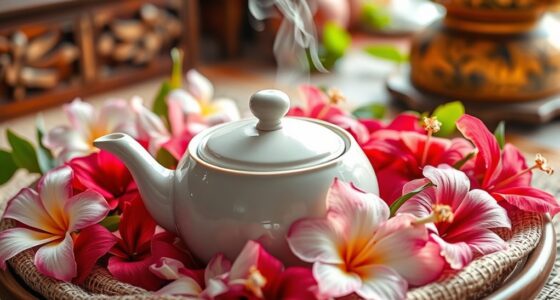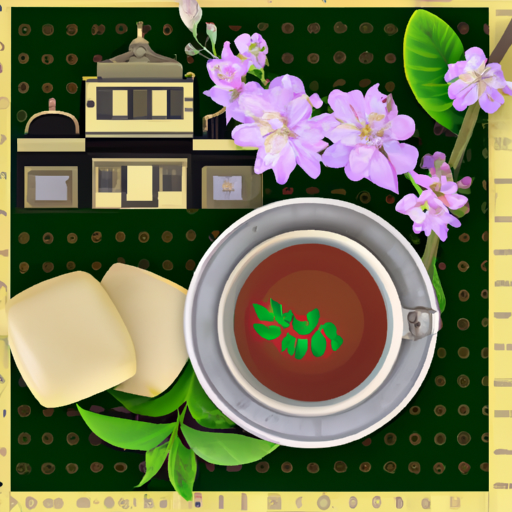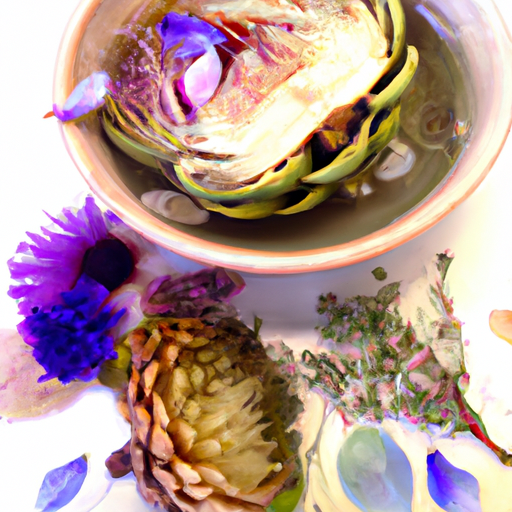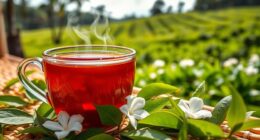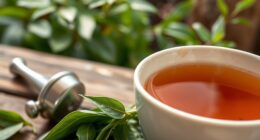Picture a graceful choreography of petals, with bright yellow chrysanthemum flowers blooming in a hot cup, spreading their aromatic scent.
Making chrysanthemum flower tea is like orchestrating this beautiful performance, where nature’s gifts blend with the art of brewing. As a tea lover and enthusiast, I have delved into the world of chrysanthemum flower tea, exploring its intricacies, health benefits, and cultural significance.
In this article, I will guide you through the process of creating this exquisite beverage, using scientific precision and a touch of artistry. From selecting the finest flowers to understanding brewing methods and enhancing flavors, we will embark on a journey that uncovers the secrets of chrysanthemum flower tea.
So, join me as we immerse ourselves in this ancient tradition and savor the wonders of this golden elixir.
Key Takeaways
- Chrysanthemum flower tea is made from specific varieties of chrysanthemum flowers that need to be dried before brewing.
- The ideal brewing temperature for chrysanthemum flower tea is around 190°F, and the brewing time should be around 5-7 minutes.
- Adding honey or sugar enhances the natural sweetness of the tea, and mixing with other herbs or teas creates more complex flavors.
- Chrysanthemum flower tea has numerous health benefits, such as being rich in antioxidants, having anti-inflammatory properties, boosting the immune system, and aiding in calming anxiety and insomnia.
Selecting and Preparing the Chrysanthemum Flowers
Are you ready to select and prep those gorgeous chrysanthemum flowers for the perfect cup of tea? Let’s dive into the first step of making chrysanthemum flower tea: selecting and preparing the flowers.
When it comes to selecting chrysanthemum varieties, it’s important to choose ones that are specifically grown for tea purposes. Look for varieties like Chrysanthemum morifolium or Chrysanthemum indicum, as they’re known for their aromatic and flavorful properties.
Once you’ve selected the right chrysanthemum flowers, it’s time to dry them. Start by gently plucking the flowers from their stems and discarding any wilted or damaged petals. Spread the flowers out on a clean, dry surface like a baking sheet or a wire rack. Allow them to air dry in a cool, well-ventilated area for about a week or until completely dry. Make sure to turn the flowers every couple of days to ensure even drying.
Now that your chrysanthemum flowers are dry, you can move on to the next step: brewing methods for chrysanthemum flower tea. The dried flowers are ready to be steeped and infused in hot water, releasing their beautiful aroma and delicate flavors.
Brewing Methods for Chrysanthemum Flower Tea
One interesting fact about brewing methods for chrysanthemum flower tea is that using hot water at a temperature of around 190°F helps to extract the maximum flavor and health benefits from the flowers. This temperature is ideal because it allows the water to fully steep the flowers without scorching them, resulting in a pleasant and aromatic tea.
The brewing time for chrysanthemum flower tea is typically around 5-7 minutes. This allows enough time for the water to fully infuse the flavor and medicinal properties of the flowers. It’s important to note that brewing the tea for too long can make it bitter, so it’s best to adhere to the recommended brewing time.
When it comes to water temperature, using water that’s too hot can also lead to a bitter taste. Therefore, it’s crucial to ensure that the water is heated to the appropriate temperature of 190°F. This will allow for a balanced and flavorful brew.
In the next section, we’ll explore different ways to enhance the flavor of chrysanthemum flower tea, including adding honey or lemon.
Enhancing the Flavor of Chrysanthemum Flower Tea
When it comes to enhancing the flavor of chrysanthemum flower tea, I find that adding a touch of honey or sugar can bring out its natural sweetness and enhance the floral notes.
Additionally, mixing it with other herbs or teas can create a more complex and layered flavor profile. By experimenting with different combinations, you can create a customized blend that suits your taste preferences.
Adding Honey or Sugar
To enhance the natural sweetness, simply drizzle some honey or sprinkle a bit of sugar into your chrysanthemum flower tea for a delightful burst of flavor that will make your taste buds dance with joy. Sweetening options like honey or sugar not only add a touch of sweetness, but also provide additional health benefits. Honey is known for its antibacterial properties and can soothe a sore throat, while sugar can provide a quick burst of energy.
Incorporating sweeteners into your chrysanthemum flower tea can be a simple way to elevate its taste and make it more enjoyable.
| Sweetener | Flavor Profile | Health Benefits |
|---|---|---|
| Honey | Sweet and floral | Antibacterial properties, soothes sore throat |
| Sugar | Sweet and subtle | Provides quick energy |
By adding honey or sugar to your tea, you can customize the flavor to your liking and enhance the overall experience. In the next section, we will explore the option of mixing chrysanthemum flower tea with other herbs or teas to create unique blends.
Mixing with Other Herbs or Teas
Mixing chrysanthemum flower tea with other herbs or teas creates a harmonious blend of flavors and aromas that will transport you to a world of botanical bliss. One popular combination is mixing chrysanthemum flower tea with green tea. Green tea is known for its numerous health benefits, such as boosting metabolism and reducing the risk of heart disease. When combined with chrysanthemum flower tea, the result is a refreshing and invigorating drink that provides the best of both worlds.
In addition to green tea, adding ginger or lemon to chrysanthemum flower tea can further enhance its taste and health benefits. Ginger adds a subtle spicy kick and has anti-inflammatory properties, while lemon provides a tangy and refreshing flavor while boosting the immune system. Together, these ingredients create a delightful and invigorating blend that is both soothing and rejuvenating.
Understanding the health benefits of chrysanthemum flower tea is crucial in maximizing its potential.
Understanding the Health Benefits of Chrysanthemum Flower Tea
The soothing aroma and delicate flavor of chrysanthemum flower tea can transport you to a serene garden, while also providing various health benefits. Chrysanthemum flower tea is not only a refreshing beverage but also a natural remedy for several health conditions.
Rich in antioxidants, this tea can help boost your immune system and fight against free radicals that cause damage to your cells. It also contains anti-inflammatory properties, which can help reduce inflammation and relieve symptoms of conditions like arthritis and allergies.
In addition to its antioxidant and anti-inflammatory properties, chrysanthemum flower tea is known for its calming effects on the body and mind. It has been used in traditional Chinese medicine to treat anxiety, stress, and insomnia. Drinking this tea can help promote relaxation and improve sleep quality.
To prepare chrysanthemum flower tea, simply steep the dried flowers in hot water for about 5 minutes. You can also mix them with other herbs or teas to enhance the flavor and health benefits. By exploring different varieties of chrysanthemum flowers, you can discover unique tastes and aromas that will elevate your tea-drinking experience.
Exploring Different Varieties of Chrysanthemum Flowers
Discover the wide array of captivating chrysanthemum flower varieties that’ll transport you to a vibrant garden of sensory delight. When it comes to chrysanthemum flowers, there are numerous options to choose from, each with its own unique qualities and flavors.
Let’s delve into the world of chrysanthemum flower tea and explore the different varieties available.
-
Snow Mountain Chrysanthemum: This variety boasts large, white flowers that resemble snow-capped mountains. Its delicate petals produce a light and refreshing tea with a subtle floral aroma.
-
Ju Hua Chrysanthemum: Known for its bright yellow petals, Ju Hua chrysanthemum imparts a slightly sweet, honey-like flavor to the tea. It offers a soothing and calming experience.
-
Gong Ju Chrysanthemum: With its vibrant purple flowers, Gong Ju chrysanthemum creates a visually stunning tea. It has a more robust and earthy flavor, perfect for those seeking a bolder taste.
Different brewing techniques can enhance the unique flavors of each variety. Experiment with steeping times, water temperature, and the amount of flowers used to find the perfect balance that suits your palate.
Now that you know about the various chrysanthemum flower varieties, let’s move on to the next section and explore tips for storing chrysanthemum flower tea.
Tips for Storing Chrysanthemum Flower Tea
To keep your chrysanthemum flower tea fresh and full of flavor, it’s essential to store it properly. There are a few storing methods that can help preserve the freshness of your tea.
First, make sure to store the tea in an airtight container to prevent moisture and air from getting in. This will help maintain the tea’s aroma and flavor.
Additionally, keep the container in a cool, dry place away from direct sunlight. Exposure to heat and light can degrade the quality of the tea.
It’s also important to avoid storing the tea near strong-smelling foods, as chrysanthemum flower tea can easily absorb odors.
Finally, try to consume the tea within six months to a year of purchase, as it tends to lose its flavor over time.
By following these storing methods, you can ensure that your chrysanthemum flower tea remains fresh and delightful.
In the next section, we’ll explore the best ways to serve and enjoy this exquisite tea.
Serving and Enjoying Chrysanthemum Flower Tea
When it’s time to savor and relish chrysanthemum flower tea, there are various delightful ways to serve and enjoy this exquisite brew. To fully appreciate the experience, it’s important to follow proper tea serving etiquette.
Begin by using a teapot and teacups specifically designed for enjoying tea. Pour the tea gently into the cups, allowing the floral aroma to fill the air. Take a moment to observe the beautiful color and clarity of the tea before taking your first sip.
The taste of chrysanthemum flower tea is delicate and slightly sweet, making it a perfect pairing with light desserts such as fruit tarts or green tea mochi. The subtle floral notes of the tea complement the flavors of these treats, creating a harmonious balance of taste.
As you savor the tea and desserts, you may notice a sense of calm and relaxation washing over you, a testament to the health benefits of chrysanthemum flower tea.
Transitioning into the subsequent section about chrysanthemum flower tea in traditional Chinese medicine, you can explore the medicinal properties and ancient healing practices associated with this remarkable brew.
Chrysanthemum Flower Tea in Traditional Chinese Medicine
After serving and enjoying a cup of delicious and refreshing Chrysanthemum Flower Tea, let’s delve into its role in Traditional Chinese Medicine.
Chrysanthemum flowers have been used for centuries in traditional recipes for their medicinal properties. These recipes often include other natural ingredients like goji berries or honey, which enhance the flower’s health benefits.
Chrysanthemum Flower Tea is believed to have a cooling effect on the body, making it a popular choice for alleviating symptoms of heat-related illnesses such as fever and sore throat. It’s also known for its ability to soothe the eyes and improve vision, making it a go-to remedy for eye strain and dryness.
Furthermore, chrysanthemum flowers are rich in antioxidants and possess anti-inflammatory properties, which can help boost the immune system and promote overall well-being.
In Traditional Chinese Medicine, chrysanthemum flower tea is often consumed as a natural remedy for a variety of ailments. Its therapeutic effects and delicate floral flavor make it a staple in many households.
Now that we understand the medicinal properties of chrysanthemum flower tea, let’s explore its cultural significance and history, where we’ll discover its deep-rooted traditions and fascinating origins.
Cultural Significance and History of Chrysanthemum Flower Tea
Chrysanthemum Flower Tea holds a rich cultural significance and has a fascinating history that will transport you to ancient times. In Chinese culture, the chrysanthemum flower is highly revered and is seen as a symbol of longevity, purity, and rejuvenation. This cultural symbolism is deeply rooted in traditional Chinese medicine, where chrysanthemum flower tea is believed to have numerous health benefits, such as improving eyesight, reducing inflammation, and soothing headaches.
The history of chrysanthemum flower tea dates back over 2,500 years. It’s said to have originated in China during the Song Dynasty and quickly gained popularity due to its medicinal properties. Over time, the tea spread to other parts of Asia and became a staple in various regional variations. For example, in Japan, chrysanthemum flower tea is often used in tea ceremonies and is associated with the changing of seasons. In Korea, it is commonly consumed during celebrations and is regarded as a symbol of happiness and good fortune.
As we dive deeper into the world of chrysanthemum flower tea, let’s explore some frequently asked questions about this delightful beverage and uncover its secrets. How is chrysanthemum flower tea prepared? What are the different types of chrysanthemum flowers used? Stay tuned to find out more.
Frequently Asked Questions about Chrysanthemum Flower Tea
Get ready to uncover the secrets of this delightful beverage as we explore some frequently asked questions about the aromatic and soothing chrysanthemum flower tea.
-
What are the benefits of chrysanthemum flower tea?
- Chrysanthemum flower tea is known for its numerous health benefits. It’s rich in antioxidants that help protect the body against free radicals and reduce inflammation. It can also promote relaxation and improve sleep quality. Additionally, chrysanthemum flower tea is believed to have a cooling effect on the body, making it a popular choice for reducing fever and treating a sore throat.
-
How do I choose chrysanthemum flowers for making tea?
- When choosing chrysanthemum flowers for tea, it’s important to select high-quality flowers. Look for flowers with vibrant colors and tightly closed petals. Avoid flowers that are wilted or have brown spots. It’s also recommended to choose flowers that are organically grown to ensure they’re free from pesticides and other harmful chemicals.
-
Can I mix chrysanthemum flower tea with other herbs?
- Yes, chrysanthemum flower tea can be mixed with other herbs to enhance its flavor and benefits. Popular choices include adding dried goji berries for a sweeter taste or combining it with dried wolfberries for an added boost of antioxidants. Experiment with different combinations to find your favorite blend.
Frequently Asked Questions
How do I know if the chrysanthemum flowers I have selected are fresh and of good quality?
To determine the freshness and quality of chrysanthemum flowers for tea, I follow a few steps.
Firstly, I carefully examine the flowers, ensuring they’re vibrant in color and free from wilting or browning.
Next, I gently squeeze the petals, looking for firmness and resilience.
Additionally, I pay attention to the aroma, as fresh chrysanthemums have a pleasant and fragrant scent.
Lastly, I check for any signs of discoloration or mold.
By following these guidelines, I can select the freshest and highest quality chrysanthemum flowers for tea.
Can I use dried chrysanthemum flowers to make chrysanthemum flower tea?
Using dried chrysanthemum flowers to make chrysanthemum tea is a convenient option. Though ‘old as the hills,’ this method retains the benefits of the tea.
Drying the flowers preserves their nutrients and antioxidants, which can help with inflammation and digestion. Plus, dried flowers have a longer shelf life, making them easily accessible.
So, go ahead and brew yourself a cup of chrysanthemum tea using dried flowers, and enjoy the health benefits it offers.
Are there any side effects or precautions I should be aware of when consuming chrysanthemum flower tea?
When consuming chrysanthemum flower tea, it’s important to be aware of potential side effects and take necessary precautions. While it’s generally safe, some individuals may experience allergic reactions, such as skin rashes or respiratory issues. Additionally, chrysanthemum tea may cause drowsiness in some people due to its sedative properties.
However, it’s worth noting that chrysanthemum flower tea also offers various health benefits. It has antioxidant properties, potential anti-inflammatory effects, and the ability to promote digestion and improve eye health.
Can I mix chrysanthemum flower tea with other herbs or ingredients to enhance its flavor?
I can certainly mix chrysanthemum flower tea with other herbs or ingredients to enhance its flavor. Not only does this add variety to the taste, but it can also offer additional health benefits.
For example, combining chrysanthemum tea with ginger can provide a refreshing and spicy twist while promoting digestion. Adding a hint of lemon can bring a citrusy note and boost the tea’s antioxidant properties.
The possibilities are endless in creating a personalized and flavorful chrysanthemum tea blend.
Can chrysanthemum flower tea be enjoyed cold or is it only meant to be consumed hot?
Chrysanthemum flower tea can be enjoyed both hot and cold, offering different flavors and benefits. While hot consumption enhances the natural floral aroma, cold brewing creates a refreshing and milder taste. Drinking it hot can provide soothing effects on the body, promoting relaxation and reducing stress.
On the other hand, consuming it cold can be a great way to stay hydrated and enjoy its antioxidant properties.
Conclusion
In conclusion, the process of making chrysanthemum flower tea isn’t just a delightful experience but also a journey into the rich history and cultural significance of this herbal beverage.
By carefully selecting and preparing the flowers, brewing with different methods, and enhancing the flavor, one can truly appreciate the unique taste and health benefits it offers.
From its traditional use in Chinese medicine to its various varieties, chrysanthemum flower tea continues to captivate and intrigue.
So why not embark on this aromatic adventure and discover the secrets hidden within each sip?



